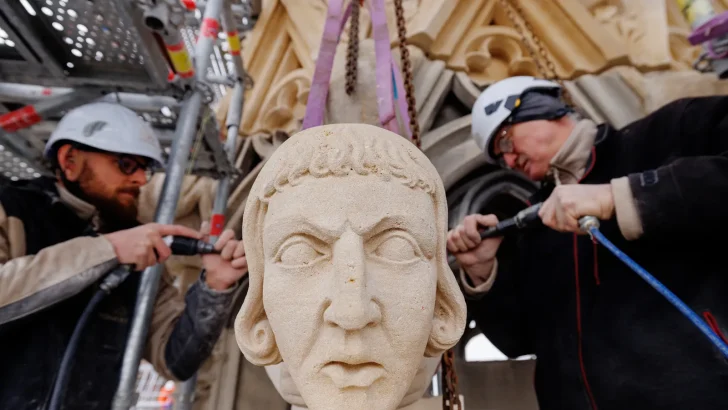The formal reopening of Notre Dame Cathedral in Paris, now fully restored after the disastrous fire on April 15 2019, will take place a month from now, on December 8. It will be an occasion with important lessons for all the world to learn from, but also one surrounded by controversy.
With this important event looming, however, disputes and disagreements still rage between the various parties involved, the French State, the Catholic Archbishop of Paris, and the experts of various kinds involved in the work. Of all of these the French government, headed by President Macron, has the final word, as the actual owners of the fabric, an outcome of the chequered history of religious institutions in France since the Revolution; the Catholic Church is merely a tenant.
Graced
The occasion will be graced by a new setting of the Te Deum, especially composed by Thierry Escaich, the new organist of the Cathedral. In an interview a couple of weeks ago with Le Figaro, he said that in his composition “I wish to capture the breath of Notre-Dame”. In this he echoes the mind of Victor Hugo, who wished to attempt the same thing in his historical novel about the cathedral, an 1831 classic of the Romantic movement in Europe. The new work will have a central part to play in the reopening service.
If the reopening will be marked by a moment in musical history, other aspects of the restoration have proved more controversial, as reported recently by La Vie, the independent Catholic magazine edited by and for the laity.
Macron and the Minister of Culture are determined by the force of their authority to imprint on the fabric of the Cathedral this “mark of the XXth century”, just as every other century since its creation has done.
The Archbishop of Paris, Laurent Ulrich, a man of advanced views who is close to both Pope Francis and Macron, has his own ambitions too. The archbishop, in opposition to the view of the experts in heritage projects, wished to replace the stained glass that was lost in the chapel on the south side of the Cathedral with new images.
Around the only surviving glass, an image of the Tree of Jesse, they wish to arrange eight panels by living artists on the general theme of the Pentecost. They want to have images showing “the bodies, the faces, the reactions of the first Christian assembly” — in which, of course, the Virgin Mary will be prominent.
But how this will be worked out remains unknown. Some fear that the result may follow that of Nevers Cathedral, where windows lost in the war were later replaced not by religious images but abstract designs. Doubts about the new scheme brought a petition with 225,000 signatures; but Macron, Dati and the Archbishop pressed ahead. We shall soon see what we shall see.
Finest
Notre Dame de Paris is seen as one of the finest examples of French gothic architecture. Before the fire it was visited annually by some 13 million tourists. All this summer across the southern countries of Europe there had been vigorous protests against mass tourism of this kind. In Venice, for instance, new taxes and restrictions have come into operation.
Though in the past local people (as in Spain and Greece) saw tourism as vital to their economic welfare. This seems no longer to be true. Tourists are still wanted but not of the all-night partying, beer swilling kind. A more select, more cultured, and one supposes, more monied tourist is sought. Only in this way can the places and the people who live in them be preserved.
Last week Minister Dati proposed that there would have to be a charge of €5 to visit the cathedral , with exceptions made for those attending mass, other services, or simply wishing to pray. Though similar charges are levied in other countries from Ireland to Greece, the Catholic Church in France and elsewhere is firmly opposed to them.
In response, Dati said this small charge on the 13 million visitors a year to the Cathedral would raise some €75 million euros which would go into the state fund for the preservation of heritage religious buildings. She claimed, indeed, that “Notre Dame would save all the churches of France. It would be a magnificent symbol”.
Across Christian Europe only some buildings of religious heritage are to be preserved; others will be found reused as everything from business offices and pubs, to community centres and theatres. It seems, in modern Europe at least, faith alone is not enough to save our physical churches, whatever about the church as a spiritual body.
We will have to see what transpires in December: Christmas celebrations this year in Notre Dame at least will be very different.


 Peter Costello
Peter Costello
